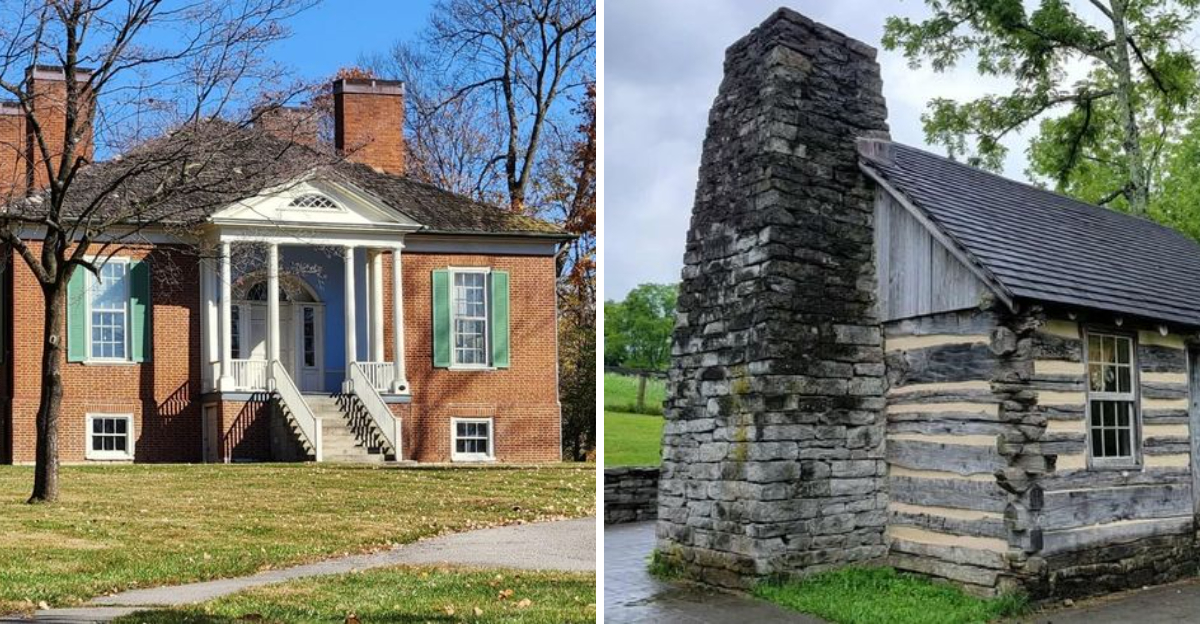10 Kentucky Stone Chimneys That Stand The Test Of Time

Kentucky’s historic stone chimneys tell stories of our past through their sturdy craftsmanship. These remarkable structures have survived centuries of harsh weather, wars, and changing landscapes.
From pioneer homesteads to grand mansions, these chimneys showcase the skill of early stone masons who built with both function and beauty in mind.
1. Liberty Hall’s Towering Sentinel
Built in 1796, this impressive limestone chimney in Frankfort has warmed generations of Kentucky’s most influential families. The stones were quarried locally and fitted together with such precision that little mortar was needed between them.
Original construction techniques included lime mortar mixed with horsehair for strength. During winter, the chimney’s substantial thermal mass would absorb heat during the day and slowly release it throughout the night, keeping the historic home comfortable even in the coldest months.
2. Shaker Village’s Perfect Proportions
The master stonemasons of Pleasant Hill Shaker Village created chimneys that exemplify their belief that work is prayer. Each stone was hand-selected for both structural integrity and visual harmony, creating a balanced appearance that reflects Shaker principles.
These chimneys feature distinctive stepped shoulders that prevent rainwater from seeping between the roof and chimney. The limestone used contains natural fossils from ancient sea creatures that once inhabited Kentucky, adding unique textural elements visible upon close inspection.
3. Ashland Estate’s Elegant Stacks
Henry Clay’s Ashland Estate features four symmetrical chimneys that have become iconic symbols of Lexington’s architectural heritage. The reddish sandstone used creates a striking contrast against the estate’s brick façade, drawing the eye upward to appreciate their craftsmanship.
Each chimney incorporates decorative corbelling near the top, showing that even functional elements deserved artistic attention. The chimneys have survived multiple renovations of the main house, standing as testament to the durability of traditional Kentucky stonework.
4. Old Fort Harrod’s Rustic Hearth
The massive central chimney at Fort Harrod State Park represents Kentucky’s frontier days when fire provided both warmth and protection. Rough-hewn limestone blocks create a sturdy structure that has survived since the fort’s reconstruction in the 1920s, based on original 1774 designs.
The wide hearth opening accommodated cooking for large groups of settlers. Blackening around the fireplace opening reveals decades of use, while the chimney’s substantial size helped draw smoke upward efficiently. Modern visitors can still experience demonstrations of period cooking techniques around this historic hearth.
5. Perryville Battlefield’s Silent Witness
Standing alone where a farmhouse once stood, this haunting chimney at Perryville Battlefield State Historic Site witnessed one of the Civil War’s bloodiest Kentucky battles. Local fieldstone was stacked with remarkable precision, creating a structure that outlasted the wooden home it once served.
Bullet marks still visible in the stones tell stories of the fierce fighting that occurred here in 1862. After the battle, the chimney served as a landmark for families searching for fallen soldiers. Today, it stands as a poignant memorial to Kentucky’s complex Civil War heritage.
6. My Old Kentucky Home’s Stately Stacks
Federal Hill, better known as My Old Kentucky Home, features multiple limestone chimneys that exemplify early 19th-century craftsmanship. The estate’s chimneys include distinctive exterior designs with gradually narrowing profiles that add architectural interest to the roofline.
These chimneys were constructed with hidden smoke chambers that improved draft while preventing downdrafts during windy days. The limestone used was quarried just miles from the estate, showcasing the practice of using local materials. Today, they remain functional while preserving the historic character of this beloved Kentucky landmark.
7. Waveland’s Symmetrical Sentinels
The four identical chimneys at Waveland State Historic Site in Lexington showcase the Greek Revival style’s emphasis on perfect symmetry. Each chimney serves two adjacent rooms, an efficient design that maximized heating while maintaining architectural balance throughout the 1847 mansion.
Master mason Richard Headley crafted these chimneys using a distinctive pattern of alternating large and small stones. The mortar includes crushed mussel shells from nearby Kentucky River beds, adding strength and a subtle sparkle when sunlight hits the surface.
8. White Hall’s Hidden Flues
Cassius Clay’s White Hall features innovative chimney design that was ahead of its time. The mansion’s stone chimneys incorporate multiple hidden flues that allowed several rooms to share a single chimney stack, an early example of efficient heating design in 1860s Kentucky.
The exterior stonework shows remarkable craftsmanship with precisely cut limestone blocks that fit together almost seamlessly. Clay, an early environmentalist, insisted on efficient fireplace designs that consumed less wood while providing more heat.
9. Farmington’s Craftsman Touches
The stone chimneys at Farmington Historic Plantation reveal Thomas Jefferson’s influence on Kentucky architecture. Jefferson, who designed the home for John Speed, incorporated dual-purpose chimneys that provided both heating and structural support for the Federal-style mansion completed in 1816.
These chimneys feature decorative stonework with subtle dentil molding near the tops. The limestone blocks were hand-cut on site by skilled enslaved stonemasons whose craftsmanship rivals professional work found in larger cities. Their enduring quality demonstrates how essential these unnamed artisans were to creating Kentucky’s architectural heritage.
10. Wilderness Road’s Pioneer Memorial
At Cumberland Gap National Historical Park stands a reconstructed chimney representing countless pioneer homesteads. Built using traditional dry-stack methods, this chimney demonstrates how early settlers created permanent structures using only local materials and simple tools.
The chimney’s hearth opening is extra wide to accommodate both cooking and heating needs of frontier families. Park rangers note that these chimneys often outlasted the wooden cabins they served, becoming poignant reminders of abandoned homesteads throughout Appalachian Kentucky.






